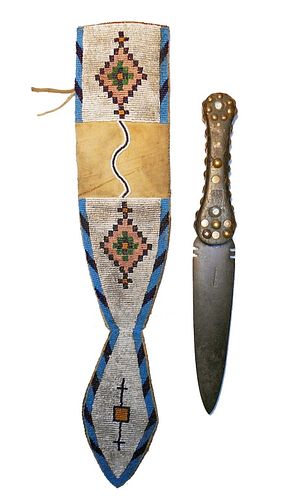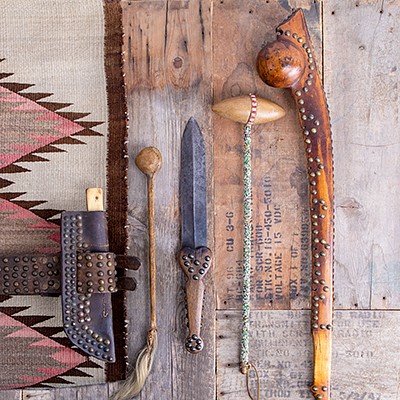Rare & Exceptional I&H Sorby Dag Knife & Sheath
Two ways to bid:
- Leave a max absentee bid and the platform will bid on your behalf up to your maximum bid during the live auction.
- Bid live during the auction and your bids will be submitted real-time to the auctioneer.
Bid Increments
| Price | Bid Increment |
|---|---|
| $0 | $5 |
| $50 | $10 |
| $100 | $25 |
| $500 | $50 |
| $1,000 | $100 |
| $2,000 | $250 |
| $5,000 | $500 |
| $10,000 | $1,000 |
| $25,000 | $2,500 |
| $100,000 | $5,000 |
About Auction
Mar 19, 2022
Explore one of the finest collections of American Indian Weapons & Beadwork along with a phenomenal assortment of Navajo Jewelry, Western History, Original Art and Luxury Jewelry. North American Auction Company tucker@naabid.com
- Lot Description
This is an exceptional and rare, original American Indian Dag fighting knife from I&H Sorby, and a beaded sheath attributed to the Blackfoot Indians of Northern Montana, dating to circa 1870. This astounding set features the I&H Sorby touch marked Dag knife paired with a traditional Dag knife sheath. This is one of the finest sets we have offered for sale. Provenance: From the historic beadwork and weapons collection of Cyrus Eaton of London, England. The knife has a traditional Dag knife pattern with double edge, dagger-like blade of a large size and double notch cuts on either side showing the heavy “I&H Sorby” in a rectangular punch touchmark on one side of the blade. The knife has a thick, solid walnut handle adorned with hot file brandings, early brass pins, and old trade brass, along with two large silver tacks on each side, a wonderful presentation ornamentation. The knife has a nice dark coloring and the handle and brass have a fine, worn, mellow patina from honest age and use. The sheath has a fine traditional Dag knife pattern with large size comprised of Indian brain-tanned Buffalo Bison hide and covered in period correct glass trade seed cen petit beads with a fantastic geometric pattern. The beadwork shows a chalk white background with a border of greasy blue and cobalt and geometric symbols at the top, bottom, and tail section with colors of Cheyenne pink, cobalt, greasy butterscotch yellow, and semi-transparent green. The center section of the sheath on the front shows only a winding beaded trail of chalk white and cobalt, likely representing a snake or river, a truly beautiful art addition. The back holds original hide tie straps, and the entire piece has a worn patina. American Indian early Dag knives are commonly referred to as “Beaver Paddle/ Beavertail” Dag knives. This is due to the fact most Dag knives were traded on the frontier, along the Great Lakes region through the St. Lawrence seaway westward, by early fur traders. From the Great Lakes region on westward, the knives became very popular among the Northern Plains/Upper Plateau tribes, such as the Cree, Metis, Blackfoot, Nez Perce, Chippewa/Ojibiwa, and Shoshone. These were made to be killing weapons—this is why Dag knives show a clean, long, double-sided blade without any serration, as they were for battle. Unlike other knives worn by Indian Warriors, the Dag knife would have been worn around the Indians neck on his chest. This is truly a very rare and early authentic set. Similar sets have sold at auction houses, such as Cowan’s, Skinners and Bonhams, for such prices as $75,000 at Cowan’s 4/5/2013 sale, $65,000 at Cowan’s 9/20/2013 sale, $70,725 at Skinner’s 2/6/2016 sale, $41,000 for a Sorby touch-marked plain handle dag from Brian Lebel’s Old West Show & Auction 6/23/2012 sale, and $78,000 at Sotheby’s 5/6/2006 sale. The example being sold in this lot is of the same quality and rarity. The blade is touch-marked “I&H SORBY (I & H SORBY)” on one side. Sorby was the hallmark of John Sorby & Sons, which was acquired by Lockwood Brothers of Sheffield, England in 1844. Lockwood Bros. still operated out of their Arundel Street Factory but created the I&H Sorby items out of their Spital Hill Works factory. The Sorby touchmark would be found on trade knives and Dag knives, which were exported to the American frontiersman and traded to the Native American Indians, where they would alter the pieces to their liking. Provenance: From the ex-collection of Cyrus Eaton of London, England. The Dag knife is 13.5” L and the sheath is 20” L by 4” W.
- Shipping Info
-
North American Auction Company is proud to announce the opening of our new in-house, full-service shipping department. We have listened to you the customer and will now be handling all outgoing packages in our new shipping department. We are confident this new offering will allow for a smooth transition from auction block to your front step. We have partnered with preferred carriers to ensure a safe, efficient delivery that works best with your schedule. Please allow 14-21 days after complete invoice payment is made to package and ship your purchase. After you are notified of your winning bids from our company and your item invoice is paid in full our new shipping department will contact you. Make sure when signing up with our company that your preferred shipping information is up to date as this information will be used to estimate shipping cost. Once the items have been packaged our team will contact you for shipping payment. Shipping invoices and payment will be completely separately than the items invoice. Please notify the shipping department with any alternate request or instructions at mark@northamericanauctioncompany.com or 800-686-4216 ext. 3. For a shipping quote please contact the same information above. PLEASE NOTE a shipping quote price can fluctuate in price. Auction company is not responsible for actual shipping cost being higher than quoted shipping cost. Thank you for trusting North American Auction Co. with your bids and shipping. As our shipping department is brand new please understand that delays can be expected.
-
- Buyer's Premium



 EUR
EUR CAD
CAD AUD
AUD GBP
GBP MXN
MXN HKD
HKD CNY
CNY MYR
MYR SEK
SEK SGD
SGD CHF
CHF THB
THB








